Autonomous sewerage "Unilos" is another solution for protection aquifers and soils with domestic waste water.
This is a newly developed deep biological treatment plant. Wastewater up to 98%.
On this moment industry produces many similar cleaning designs suitable for mounting on suburban areas and cottages.
The work of the Unilos Astra septic tank is carried out automatically and does not require human participation.
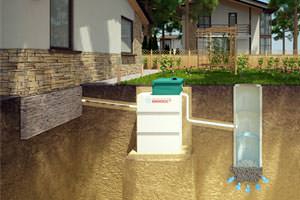 The septic works like this:
The septic works like this:
- First, wastewater enters the receiving chamber, where, under the pressure of the air coming from below, they are mixed and clarified.
- Water that has undergone preliminary clarification, under the action of an airlift, enters the aerotank, in which, under the influence of constantly supplied oxygen, it is purified by activated sludge.
- The Unilos Astra septic tank uses an intermittent aeration method that helps to effectively remove nitrates from wastewater.
- The secondary clarifier is used to settle the activated sludge in a suspended state.
- With the help of an airlift, the sludge that precipitates falls into a sludge sump, where pure water is brought out.
The advantages of the Unilos treatment system are as follows:
- Low cost and convenient integration of a septic tank.
- Wastewater treatment is fully automated.
- Low power consumption.
- High tightness ensures the absence of unpleasant odors.
- Long service life.
- Aesthetics.
For country houses most commonly used treatment facilities Unilos "Scarab", "Cyclone" and "Astra".
They are equipped with tanks that allow you to treat 0.6-30 m 3 of wastewater, and work great when processing wastewater in residential buildings with the number of residents from 3 to 150 people.
How to choose a model
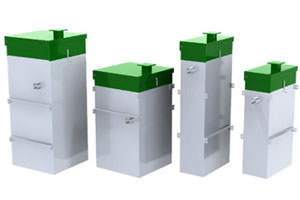 Consider septic tanks Unilos Astra 3 and Unilos Astra 5.
Consider septic tanks Unilos Astra 3 and Unilos Astra 5.
The number at the end of the model designation indicates the number of people for which the treatment system is designed.
The price of a Unilos septic tank increases with the number of residents of the house.
If we compare the most popular models, we get the following:
- The Unilos Astra 3 septic tank is considered the most compact treatment plant with not very big power suitable for working in small or medium area country house where three people live.
- Septic Unilos Astra 5 is the best combination of price and power. Works most effectively in a house with five tenants.
- Once a week, carry out a visual inspection of wastewater.
- Remove sludge from tanks and settling tanks once every 3 months
- Once every 3 months, clean the mamut pump, filters, blower and hair trap.
Proper and high-quality maintenance can only be carried out by trained personnel.
But you can independently perform the required procedures for maintaining the station, subject to strict observance of all requirements.
Station maintenance - how to remove silt
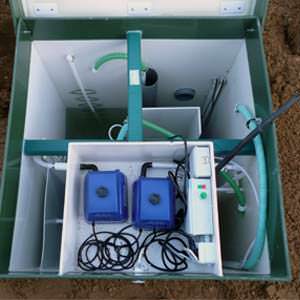 The Unilos Astra local treatment plant does not require special skills for its maintenance - it is just necessary to remove excess activated sludge from time to time.
The Unilos Astra local treatment plant does not require special skills for its maintenance - it is just necessary to remove excess activated sludge from time to time.
To find out whether it is time to remove sludge from the septic tank or not, you need to know in what time period sludge forms in the tank.
After the first start, sludge accumulates within 30-40 days.
The newly formed silt is colored brown. After 10-15 days, purified water becomes better and cleaner.
The longer the operating time of the Unilos septic tank, the thicker and darker the silt becomes, and at the outlet the water becomes clean and not without extraneous odors.
How is the sludge removed?
There are certain rules according to which water is pumped out only from the stabilizer. From the Unilos septic tank, water is pumped out by a mamut pump, and pumping goes like this:
- On the control unit, the switches must be installed in the following order: "COMPR." — "0", "MANUAL" - "1", "RETURN." - "0".
- Then you need to wait 25-40 minutes and remove the plug on the sludge stabilizer and on the hose of the mamut pump.
- Then the switch "COMPR." set to position "1".
- After that, the pumping of sludge into the prepared container begins.
- Inside the septic tank, it is necessary to leave half the volume of the liquid in it.
- At the end of pumping out, the “COMPR.” switch and switch "MANUAL." should be set to "0".
- The plug on the mamut pump hose must be reinstalled.
- Fill the septic tank with water up to the green marks on the walls.
Such procedures must be performed once every 3 months.
There is another method for pumping sludge into Unilos:
- On the control unit, the "Valve" and "Compressor" switches must be set to the "0" position.
- With help drainage pump completely pump out the sludge from the tank. To do this, the pump must be placed in a sludge stabilizer tank.
- After pumping out, fill the container completely clean water evenly until green marks on the walls.
- Upon completion of all operations, set the "Valve" and "Compressor" switches to position "1".
These procedures for the Unilos septic tank can be carried out every 6 months.
Price
Price model range Unilos septic tanks are directly proportional to their performance and terms of sale. Inexpensive Unilos models have a performance designed for 3-5 residents.
With the help of the most expensive treatment plants, it is possible to equip a common sewage system for several residential buildings with a total of up to 150 residents.
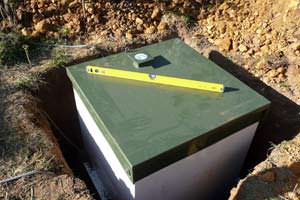
If you order a septic tank with a turnkey installation, then the cost of delivery and installation is reduced accordingly.
The approximate cost of the most popular septic tanks as of 20134 is shown in the table below.
Bioseptic is a local treatment plant (VOC) based on microorganisms. In this article, by bioseptic we mean as a station of deep biological treatment sewage, and septic tanks equipped with a biofilter.
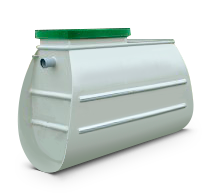
Wastewater in a bioseptic tank cleansed by the activity of specialized bacteria. This is the fundamental difference between a biological treatment plant and a conventional septic tank.
The bioseptic tank produces purified water (depending on the type of product and the requirements for water) from 65% (for septic tanks with a filter) to 95-98% (for bio-treatment stations).
Principle of operation
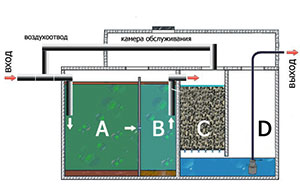
Technically, a bioseptic tank is a sealed container, reinforced with stiffeners, divided into several sections. The number of sections corresponds to the number of cleaning steps.
Communication between sections is provided by a system of overflows.
Waste water from the house, getting through the pipe inside the biological treatment plant, undergoes sequential purification various methods. The resulting water can be use for irrigation or drain into a roadside ditch, soil or water.
The first section of any septic tank - the primary clarifier - provides rough wastewater treatment mechanically. Suspensions in the form of large and small particles (solid household waste entering the drain through a sink or bathroom) settle to the bottom under the influence of their own weight. The sediment accumulated over time must be removed.
Substances, the weight of which allows them to stay afloat, form a dense film on the surface of the water over time. Based on these features, the hole through which the effluents overflow from the first section to the second is located above the sediment level, but below the film floating on the surface.
Depending on the design of the bioseptic tank, partially treated wastewater enters either a secondary settling tank - a digester or an anaerobic chamber, or directly into the biological treatment chamber.
Chemical and organic compounds (food residues, household chemicals, personal hygiene products) under the action of facultative microorganisms (there is no need to add them specially, they are already present in the drains) decompose during fermentation - acidic, and after methane. As a result compounds that are difficult to oxidize are converted to easily oxidized. The digester must be kept oxygen deficient, otherwise fermentation will not occur.
The effluents clarified in this way are poured into the third chamber, where they are purified by the vital activity of microorganisms.
Biological treatment of local sewerage can be implemented in 2 different ways:
- Biofilter;
- Aerotank or deep cleaning septic tank.
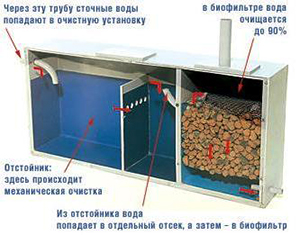
The design of a septic tank with a biofilter suggests the presence a limited field for the vital activity of bacteria, sort of their place of residence. Most often, this is a compact container with an inert (not entering into chemical reaction) backfill, on which bacteria live, forming a dense film.
As a filler for the filter, any light porous material- expanded clay, shungizite, coke, nylon threads, various brushes, foam plastic, shell rock, etc. There is only one condition - the material must be resistant to decay.
The biofilter also acts as a mechanical barrier, retaining the remaining large waste particles.
In the course of their life activity, microorganisms, feeding on sewage, process them into sludge, which, after pumping, can be used as organic fertilizer.
Under the tank with a filler is a reservoir into which treated wastewater enters. After processing, they can merge immediately into the soil. There is no need for soil post-treatment, since the mechanism of the biofilter is identical to the treatment of wastewater in the soil, however, in a bioseptic, the process is faster.
Aerotank
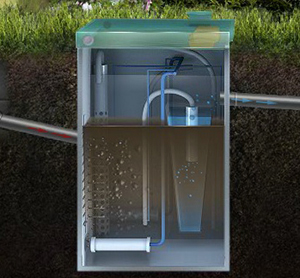
The principle of operation of the aeration tank is based on the activity of exclusively aerobic bacteria, in contrast to a septic tank with a biofilter operating in an anaerobic environment (without oxygen).
The pumping of water into the aerotank is carried out with the help of airlifts - special lifts operating on compressed air.
In the aerotank there is no specialized place for the activity of bacteria. Wastewater freely mixes with activated sludge - a special mixture of bacteria and protozoa.
Intensive mixing of wastewater and sludge is carried out due to the operation of special devices - aerators, which also saturate the water with oxygen, making possible process oxidation. After treatment of wastewater with sludge, the mixture is fed to the next section, where it is settled. The sludge that has fallen to the bottom is returned to the aeration tank, and the treated effluents are returned to the exit.
Comparative characteristics of 2 types of bioseptic
| Biofilter | Aerotank | |
| Effluent supply | in portions | continuously |
| The need for air | depending on the type of microorganism | needed |
| Additional design elements | anaerobes - no / aerobes - ventilation pipe | aerators, airlifts, secondary clarifier |
| Need for electricity | Autonomous subject to gravity flow of water at the outlet | necessary for the operation of aerators and airlifts |
A septic tank with a biofilter has several advantages over an aeration tank: complete autonomy in terms of electricity and ease of use: when using anaerobes in a biofilter, you can simply pour them into the toilet bowl, the bacteria will enter the filter on their own.
In turn, the aerotank does not need to be insulated (with constant stirring the probability of freezing of drains in winter tends to zero, also bacteria in the process of recycling produce a large number of heat) and provides an even faster process of water purification by saturating them with oxygen, which allows oxidation to occur at an accelerated pace.
The degree of wastewater treatment in the aeration tank is higher than in a septic tank with a biofilter.
Maintenance of bioseptic tanks has its own specific features depending on the type. So, in addition to the regular (about 1 time per year) call to the sewage service to pump solid sludge from the primary sump, a septic tank with a biofilter also needs periodic cleaning, since over time the bacterial film grows, which leads to silting backfill.
Aerotank needs procedures to remove dead sludge. This can be done independently using the pump built into the system. Elements such as airlifts and aerators also need to be cleaned as they get dirty, but at least once a year.
Advantages of bioseptics:
- Environmental friendliness;
- Ease of installation and operation;
- autonomy;
- Durability (resistance to corrosion due to the absence of metal elements);
- Reliability;
- Great performance;
- Versatility for any soil;
- Compactness;
- Maintenance is rarely required;
Flaws:
- High cost + maintenance costs;
- Inability to drain aggressive (chlorine-containing) compounds into the sewer;
- The need for constant use of sewage, with long-term idleness, colonies of bacteria die.
Comparison of the most popular bioseptic models
On the bioseptic market, there are several models that are most popular. Their comparison is shown in the table.
| Model | Material | Location | Performance | cleaning |
| Poplar | polypropylene | vertical | 1.1-12 cubic meters | aeration tank |
| eurobion | polypropylene | vertical | 0.4-25 cubic meters | aeration tank |
| Aster | polypropylene | vertical | 1.0-6 cubic meters | aeration tank |
| Biotank | polypropylene | vertical | 0.75-6 cubic meters | combined |
| Topas | polypropylene | vertical | 1.0-1.8 cubic meters | aeration tank |
| Tver | polypropylene | horizontal | 1.0-24 cubic meters | combined |
Productivity is specified per one day for the entire line of the model range. The combined cleaning method means that both a biofilter and an aeration tank are present in the bioseptic tank.
The Eurobion local treatment plant is the only one of those presented that has a sludge self-oxidation system, which makes it possible to make work intervals of up to 3 months.
Each of us cannot imagine our life without simple but necessary amenities in own house: water, electricity, gas. This applies not only to urban residents - the owners of private houses, cottages and summer cottages also choose comfort and increasingly install autonomous sewage, heating, and water supply systems. These solutions require competent design and qualified approach.
Thus, the problem of storage, treatment and disposal of wastewater is of particular importance when installing an individual sewer system. Often they solve it, as they say, in the old fashioned way - they equip a cesspool and periodically empty it with the help of a sewage machine. However, this is not always convenient: the pit requires constant monitoring, high-quality insulation for the winter period, and eventually collapses, needs repair, or even becomes unusable. In addition, pit latrines and septic tanks can cause significant damage to the environment and are not the best solution in terms of hygiene, especially if they are located next to a well from which water enters the house. Today there is a more effective method for solving the problem of wastewater treatment and disposal than a cesspool and septic tanks. This is an autonomous station for deep biological treatment (SGBO), otherwise called an aerotank.
The main difference between a deep biological treatment plant and a septic tank is its efficiency. Filtered water does not need additional purification in filtration fields or in filtration wells; it can be safely drained into a nearby ravine, reservoir or into the ground. If there is a disinfection system in the aeration tank, the purified water can even be reused, for example, for watering the garden and other agricultural needs. In addition, at correct work wastewater does not emit an unpleasant odor.
The principle of operation of modern stations combines the mechanical and biological methods of wastewater treatment. In the first compartment, as a rule, sand and other insoluble contaminants are screened out, and at the next stage, the water undergoes biological treatment. It is worth noting that water is poured between the compartments not through a pump, but with the help of air bubbles, which are pumped, as a rule, by a compressor. All this creates a favorable environment for aerobic bacteria that absorb human waste products from wastewater, purifying them by 97-99%. As a result, dark brown silt remains at the bottom of the tank, which is odorless and does not pose a danger to the environment.
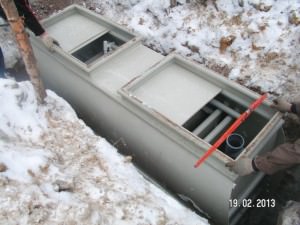 Modern manufacturers offer a huge selection of deep biological treatment plants, and the choice desired installation must take into account several factors:
Modern manufacturers offer a huge selection of deep biological treatment plants, and the choice desired installation must take into account several factors:
The number of people living in the house.
"Seasonality" of the use of the sewerage system.
Maximum volley discharge of sewage into the sewer. This indicator indicates how much water the sewerage system receives from sinks, toilet bowls, bathtubs and other spillway points at the same time.
IN general case you can be guided by simple statistics, according to which each person on average consumes about 200 liters of water daily. It turns out that with regular use of water supply for a family of 5 people, you need to choose a biological treatment plant with a volume of 1000 liters.
As for the number of cameras that make up the installation, the best solution for a private house, summer cottage or small cottage will be an aerotank of 3 departments. For a mansion and a large house, you can choose a four-chamber system.
So, the installation is selected, proceed to the installation. First, you should decide on the place where the aerotank will be installed and dig a pit. According to general requirements, the station should be located no closer than 8 meters to the canalized object and the well from which clean water enters the house. We fill the bottom of the pit with a sand-cement mixture about 0.2 meters high, and then we dig a pit for the pipeline based on a pipe with a diameter of at least 110 mm. The station must be installed on a sand-cement cushion as carefully as possible, in a strictly horizontal position. Then manually knock out all the sinuses and seals and spill with water to better fill them.
The correct location of the biological treatment system is the key to its long and trouble-free operation. Special attention should be given to its installation. For example, many modern stations do not require anchoring, as they have special devices- the so-called bottom lugs. In other cases, the aerotank is installed on concrete base, "anchored" with concrete slabs, anchor straps or other means. These measures will make the aerotank resistant to displacement, which may be caused by freezing groundwater or its mobility.
The next stage of work is the internal filling of the installation compartments - if necessary, expanded clay, crushed limestone and other materials are poured in, ruff garlands are mounted on metal or plastic pins. When these stages are completed, the station is filled with water to the level of the weirs.
In regions with long winters and severe frosts, it is worth taking care of the station insulation. This can be done in two ways: firstly, the installation itself must be located below the freezing level of the soil, and secondly, the pit must be made slightly wider than the aerotank. This will allow you to accept additional measures for the insulation of a biological treatment plant. Most often, an electric heating cable is used for this.
The last step in the installation of the entire system is the laying of pipes and the installation of additional equipment (compressor, units for disinfection).
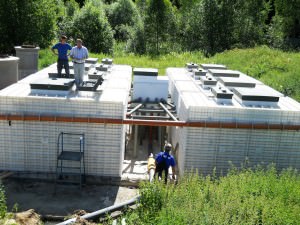 After installation, the installation is started for cleaning sewage water. The first thing to consider is the correct aeration setting. It is important to understand that in aerotanks the main work is performed by aerobic bacteria, which intensively consume oxygen. That is why the SSBO requires the installation of a compressor that continuously pumps oxygen into the system. This causes a high degree of wastewater treatment and the speed of this process. Here lies one of the disadvantages of using aerotanks - if the compressor fails, all active aerobic bacteria will die, and the restoration of microflora will take at least a month. We add that other disadvantages of the biological treatment plant are the higher cost compared to a conventional septic tank and the cost of electricity. However, all the disadvantages of using these installations are compensated by their advantages described above.
After installation, the installation is started for cleaning sewage water. The first thing to consider is the correct aeration setting. It is important to understand that in aerotanks the main work is performed by aerobic bacteria, which intensively consume oxygen. That is why the SSBO requires the installation of a compressor that continuously pumps oxygen into the system. This causes a high degree of wastewater treatment and the speed of this process. Here lies one of the disadvantages of using aerotanks - if the compressor fails, all active aerobic bacteria will die, and the restoration of microflora will take at least a month. We add that other disadvantages of the biological treatment plant are the higher cost compared to a conventional septic tank and the cost of electricity. However, all the disadvantages of using these installations are compensated by their advantages described above.
Second important aspect to start the wastewater treatment system is the sowing of microflora. The fact is that aerobes that clean sewer drains, live in human waste and appear only after the first use of a biological treatment plant. However, at the beginning of the operation of the aerotank, their number will be minimal, and it will be impossible to achieve water purification up to the 99% declared by the manufacturer. This result can only be achieved after 4-8 weeks of regular use of the system. Today there is a great opportunity to speed up this process by 2-3 times. For these purposes, preserved bacteria developed by biotechnologists are used. Sowing microflora will allow in just a couple of weeks to restore up to right level population of aerobic bacteria.

With proper and careful operation, an autonomous sewage treatment plant serves for many years, but there are a number of rules that will help extend its operation in an accident-free mode.
Firstly, a good owner must take into account volley discharges not only during the installation of the system, but also during its operation. The largest water consumption shows corner bath and jacuzzi tub. They have this figure, according to the regulations, is about 450 liters. For comparison: a conventional bathtub has a corresponding indicator of 220 liters, a shower cabin - 100 liters, a sink - 20 liters, and a toilet bowl - 10 liters. Accordingly, if a corner bath, a toilet bowl and a faucet in the kitchen simultaneously drain water in the house, then a volley discharge into the treatment system enters about 480 liters in volume, and this indicator must be taken into account when choosing and operating a wastewater treatment plant.
Secondly, the second important aspect in the operation of the station is its recovery after long downtime. This is especially true in summer cottages, where the water supply system is used seasonally, and not all year round. Strictly speaking, in houses with seasonal residence, the installation of an aerotank in itself is not advisable, since in the absence of organic waste, aerobes are deprived of food and simply die. Restoration of microflora, as already mentioned above, is a rather troublesome and costly business. In this case, it is better to opt for a conventional septic tank, so the investment and effort will be justified. If, nevertheless, for some reason, the deep biological treatment plant was inactive, be patient and restore its operation. For this, canned bacteria are usually used, which will quickly bring the amount of aerobes to the required level and, accordingly, speed up the process of restoring the entire system, and you will again be able to use the wastewater treatment plant as usual.
The third aspect that needs to be paid attention to when maintaining the system is the pumping of activated sludge. Activated sludge is the biomass suspended in water, which carries out the purification process. Excess organic matter entering the aeration tank with wastewater and a large amount of oxygen contribute to the growth of bacteria that form flocculent substances Brown and 4-5 mm in size. Over time, activated sludge mineralizes and forms in the form of a high-density bottom sediment, which does not have the best effect on water purification: aerobic bacteria remain in the dense bottom sediment, acting only on the surface. To do this, it is recommended to pump out activated sludge from the aerotank several times a year.
Summing up
Autonomous station for deep biological treatment is the best solution for anyone who wants to establish uninterrupted operation of water supply and sewerage systems in a private house, country cottage or on suburban area. Right choice, high-quality installation, accurate operation and constant monitoring of the operation of the aerotank will solve the problem of wastewater treatment and disposal and will be a good investment.
Alexei 10.10.2014 Septic tanks
What should be sewer system so that regular pumping of wastewater from storage tanks is not required? Cesspool - needs to be cleaned at least once a year.
The septic tank is also not ideal and will require periodic pumping of solid sediments for its operation. Is it really impossible to create an autonomous treatment system that does not require calling a specialized machine?
It turns out you can. This task can be easily handled by equipment that uses a biological decomposition method in its work. Of course, it is expensive, but in the end it will save you a lot of trouble.
For those who have not yet decided that a septic tank or SBO is better, this article is intended. In it, we will analyze the main differences between these devices and decide which of them is more profitable to install on your site.
How important is sewage treatment in the house
Disposal of domestic wastewater is the number one task for the private sector. And the fact that one cannot do without special equipment is clear to everyone. After all, today in the process of washing, cleaning, washing dishes, various chemicals. Getting them into ground water or the soil is detrimental to environment.
Therefore, in the area where there is no central sewerage have to arrange autonomous systems. Otherwise comfortable conditions existence in a private house is impossible to achieve.
Septic tanks - features of functioning
The modern market offers various equipment for creating autonomous sewerage. It is represented by a variety of models of septic tanks and treatment plants. Which one to choose? The answer to this question depends on many reasons.
Let's say you decide to stay on a septic tank. First you need to clearly understand for yourself that it is most often a plastic container, divided into several sectors, each of which has its own purpose. So, the first one is used to collect and settle wastewater. In this case, the harder components settle to the bottom, and the liquid flows into the further cleaning chamber.
Here, further decomposition of wastewater occurs and again the more liquid part flows into the third compartment, and large fractions settle to the bottom. In the last tank, water is cleaned and discharged to the filtration fields. This is the principle of operation of the simplest septic tank.
types of septic tanks
There are many various kinds such structures. They are divided according to the following criteria:
- Material (plastic, fiberglass, metal, concrete)
- Installation method (recessed, surface)
- Processing method (with biological post-treatment or mechanical)
As you can see, the choice is wide enough, which makes it possible for everyone to choose a sample in accordance with certain requirements. But all types of septic tanks, even deep biological treatment, have one drawback. No matter how modern they are, you still have to pump out the solid mass of them. Albeit not as often as cesspool, but necessary.
SBO - what is such equipment
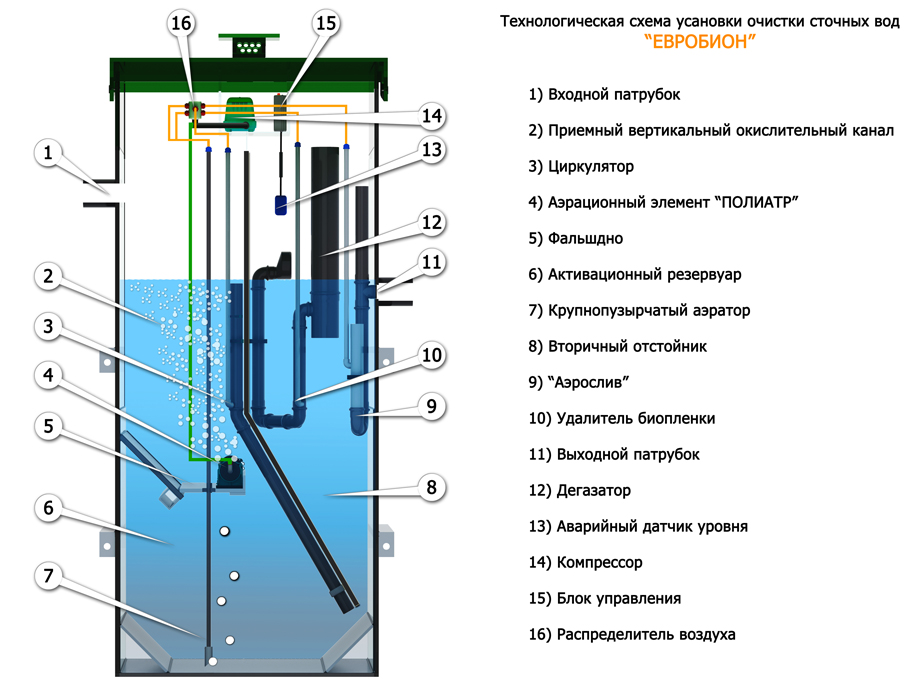
Device and circuit
The main difference between a septic tank and a SBO is the fact that the first one is able to clean the drains by only 60%. At the same time, it uses the method of natural gravity (when solid fractions accumulate in a sump). This leads to the need for periodic pumping of wastewater using special machines and, therefore, additional costs.
In addition, water after a septic tank cannot be used even for technical purposes; they must be sent to filtration fields or to a special well. The station operates on the principles biological method decomposition of impurities. Moreover, both anaerobic and aerobic bacteria are involved in the process.
The degree of purification with this approach reaches 98%. And besides, the sludge accumulated after cleaning is an excellent organic fertilizer. If, during the operation of the station, additional disinfection of wastewater with ultraviolet light is used, then they can even pour out into open water bodies.
As for pumping sludge, a machine is not needed for this. An ordinary drainage pump is sufficient. Another advantage of the biological treatment plant is the impossibility of its floating up during the spring flood, as the station is constantly filled with water. Not to mention the complete absence of unpleasant odors.
From the bad: high cost. But the lack of costs for arranging filtration fields and calling a sewage truck practically equalizes the prices for a septic tank and a station.
Cost - is it profitable to purchase such equipment
Prices for biological treatment plants depend primarily on permissible load. For a model recommended for installation in a house where 6 people live, it is about 1700 euros and is the minimum. The maximum cost of such equipment, designed for a large number of people, can reach 24 thousand euros.
Therefore, a septic tank with biological treatment should be chosen taking into account the expected load. If in your cottage settlement it was decided to install one cleaning station for all, then perhaps this will be a cheaper option. However, you need to decide on your own, taking into account your own criteria and capabilities.
Features of choosing SBO
The biological treatment plant must meet certain requirements. First of all, pay attention to the size of the installation. Its volume must be greater than the level of those arriving for a period of at least three days. With smaller plant sizes, its operation becomes inefficient.
In addition, the equipment must be durable, so most models are made of fiberglass. But not only specifications are important when choosing, no less attention should be paid to the installation price and the cost of installation work.
Watch the video, selection criteria:
If the station is purchased for country house, which assumes residence only in the summer, it is better to choose a hybrid model. With regular flow of effluents, it works as usual, but with a decrease in volume, it switches to septic tank mode.
What to install and how to choose
 Having understood the differences between these two devices, it is easier to choose one of them. Since the difference between them is significant, and especially in cost, for small country houses the acquisition of such equipment is inappropriate. For the summer period, the simplest septic tank is enough.
Having understood the differences between these two devices, it is easier to choose one of them. Since the difference between them is significant, and especially in cost, for small country houses the acquisition of such equipment is inappropriate. For the summer period, the simplest septic tank is enough.
But in a private country cottage, where a large number of people live, it is better to use biological treatment plants. Of course, they have a higher cost, but they are efficient and reliable in operation. The service life of such equipment is at least 50 years, so all costs will pay off.
When operating the SBO, the services of a sewage machine are not needed, and you can pump out the sludge yourself. Such a system works in all weather conditions and is able to disinfect wastewater of various composition. Its installation is admissible both on sand, and on clay because the design is absolutely tight.








